Publications
IAHS publishes Hydrological Sciences Journal and three book series:
- the Benchmark Papers in Hydrology series that collects together, by theme, the seminal scientific papers that provided the foundation for modern hydrology.
- the "Red Books" or Proceedings and Reports series and from volume 369 (2016) the new online open-access proceedings journal, Proceedings of the International Association of Hydrological Sciences, PIAHS.
- the "Blue Books" or Special Publications series.
Details of all books are provided below. Papers in Red Books (except 24, 25, 26 and 50) are available to view/download as pdfs. To directly access the different series, for example Blue Books, use the 'Category' option in the Search area. To search for specific books by title, ISBN, Editor or publication number use the facility below. To search for specific papers/authors use Paper Search. Books can be purchased online by clicking on the shopping basket to purchase. Members receive discounts. The Catalogue and June 2015 Update can be viewed/downloaded.
HSJ Digest
The HSJ Digest is our bi-monthly synopsis of the latest news from Hydrological Sciences Journal. Find links to all the articles published in the latest issues of the Journal, together with the Editors’ choice of featured articles and various other news and noteworthy items.

Enquiries: [email protected]
tel: +44 1491 692515
IAHS, UKCEH Wallingford, Oxfordshire, OX10 8BB, UK
Changes in Flood Risk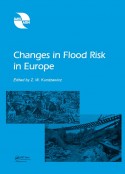 Author / Editor: Zbigniew W. Kundzewicz Price: £85.00 Floods are the most prevalent natural hazard in Europe. But, has flood risk increased in the continent? How, where, and why? Are climate change impacts apparent? How do socio-economic trends and associated land-use change impact flood risk? This interdisciplinary book, authored by an international team, offers: • A comprehensive overview of flood risk in Europe, past and present, and future • National/regional chapters covering Central Europe, Western Europe, Southern Europe and Northern Europe, the Alpine region and the Iberian Peninsula. • A focus on detection and attribution of change with respect to climate change and its impacts, water resources and flood risk, the re-insurer’s view point, and future projections of flood risk • Rectification of common-place judgements, e.g.: “climate is warming so floods should become more frequent and intense”; observations do not always confirm this expectation | Leonardo Da Vinci's Water Theory: On the origin and fate of water Author / Editor: Laurent. Pfister, Hubert H. G. Savenije & Fabrizio Fenicia Price: £25.00 Leonardo Da Vinci (1452-1519) was not only one of the greatest artists of his time, he was also a great engineer and scientist. A large part of his scientific work was dedicated to understanding the movement, circulation and physical characteristics of water in its different forms. This book aims to make Leonardo Da Vinci's contributions to the science of water accessible to a wider public and to compare his ideas with our present knowledge. Fascinating, revealing and inspiring, Leonardo Da Vinci's Water Theory opens up a new history to the study of water. Two hundred years before Newton, Perrault and Halley, Leonardo Da Vinci was doing hypothesis-driven science and describing and classifying hydrological processes. For example, he came close to the modern definition of the hydrological cycle, recognising that water passes through the major river systems countless times, summing up to volumes much greater than those contained in the world's oceans. | ||||||||||||||||||||||||||||||||||||||||||
Climate and the Hydrological Cycle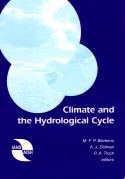 Author / Editor: Marc Bierkens, Han Dolman & Peter Troch Price: £50.00 An in-depth overview of the role of the hydrological cycle within the climate system, including climate change impacts on hydrological reserves and fluxes, and the controls of terrestrial hydrology on regional and global climatology. This book, composed of self-contained chapters by specialists in hydrology and climate science, is intended to serve as a text for graduate and postgraduate courses in climate hydrology and hydroclimatology. It will also be of interest to scientists and engineers/practioners interested in the water cycle, weather prediction and climate change. Contents for Climate and the Hydrological Cycle | HYDROLOGY: A question of balance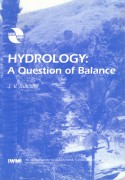 Author / Editor: J. V. Sutcliffe Price: £30.00 Hydrology: A Question of Balance is a unique hydrology text. It brings hydrological analysis to life by means of examples in which the author has been involved: numerous practical problems that had to be tackled (often despite limited data, resources and time) are described and the methods that were used to find a solution are explained. The application of a water balance is an essential component of solving these applied problems. John Sutcliffe offers the experience of a hydrologist with extraordinary practical expertise, assembled in areas with different climates, topographies, levels of development, and cultures. Projects in many countries, including Sudan, Iran, Senegal, Botswana, India, Sri Lanka, New Zealand, Bosnia, Poland and the UK, are detailed to illustrate how hydrologists can, and need to, use all the available information to understand the hydrological context of their studies. Practising hydrologists and engineers, as well as students, will learn from this volume which complements standard hydrology textbooks.
Contents for HYDROLOGY: A question of balance | ||||||||||||||||||||||||||||||||||||||||||
The Ecohydrology of South American Rivers and Wetlands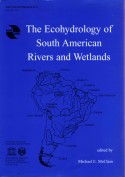 Author / Editor: Michael E. McClain Price: £39.50 An overview of ecohydrological processes operating in South America’s most important aquatic systems. River reaches ranging from pristine to heavily impacted and processes operating in channels, wetlands, and riparian environments are considered. The Amazon, Orinoco, and Paraná, receive the greatest attention, but the condition of the Piracicaba (São Paulo) and the ParaÃba do Sul (Rio de Janeiro) are also evaluated. There is an urgent need for action— many spectacular ecosystems remain to be preserved. The natural attenuation processes in these ecosystems stand to aid South America in achieving its goal for sustainable use of its resources Ecohydrological processes serve to regulate environmental conditions within aquatic systems, maintaining energy levels, water quantity and water quality, within ranges suitable to native flora and fauna. South America, the wettest and most ecologically diverse continent on Earth with an unrivalled waterscape of giant rivers and wetlands, has great opportunities to capitalize on the natural attenuation effects of ecohydrological processes. South Americans have greatly benefited from the resources derived from their rivers and wetlands, but these aquatic systems have not generally benefited from their association with humans. Dam building, dredging, and canalization are expanding across the continent, eliminating the natural flow regimes of many river reaches and draining wetlands. Much riparian vegetation lying along river margins has been removed. Disturbance of riparian zones has changed the rates of material exchanges from land to aquatic systems, generally increasing erosion and contaminant fluxes. Uncontrolled waste discharges have also degraded water quality in many urban rivers and wetlands, with consequent negative impacts on the health of many urban and downstream rural poor Contents for The Ecohydrology of South American Rivers and Wetlands
| The Hydrology of the Nile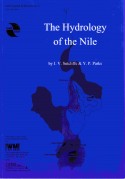 Author / Editor: J. V. Sutcliffe & Y. P. Parks Price: £15.00 This book presents an account of the hydrology of the whole Nile basin, dealing with each tributary in turn but drawing attention to links between reaches. The Nile is shown to be a set of very different tributaries which came together by geological accident. Nevertheless, evidence from one part of the basin often throws light on a different area. Recent changes are discussed, in particular the dramatic change of regime of Lake Victoria and other lakes which occurred after 1961. The relationship between hydrology and vegetation affects the important wetlands of the White Nile basin, and discussion of this relationship includes the effect of increased lake outflows. The authors draw on the extensive records collected throughout the basin to paint a detailed hydrological picture of the regime of the Nile. The book is illustrated by over 100 diagrams and photographs, and its scope is indicated by the list of contents overleaf. J. V. Sutcliffe has worked on all the major Nile tributaries over a period of 50 years and has been the author of many papers and reports on the different hydrological problems. Y. P. Parks has worked on hydrological models of the Sudd and on water resources problems of several Nile tributaries Contents for The Hydrology of the Nile | ||||||||||||||||||||||||||||||||||||||||||
The Use of Suspended Sediment and Associated Trace Elements in Water Quality Studies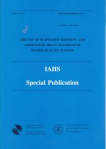 Author / Editor: Arthur J. Horowitz Price: £14.50 Suspended sediment plays a key role in the biological and geochemical cycling of trace elements in aquatic systems. As such, suspended sediment can be and is used in a variety of environmental and water quality studies. Anyone attempting to design a study involving the collection, processing and subsequent analysis of suspended sediment must develop a clear understanding of the problems associated with using this sample medium. Of particular concern are the short- and long-term spatial and temporal variations in the distribution and concentration of suspended sediment and associated trace elements that commonly occur in fluvial systems. Since 1987, the U.S. Geological Survey’s Office of Water Quality has sponsored a number of studies designed specifically to address many of the problems associated with using suspended sediment in water quality programmes. The results of these studies are summarized in this IAHS Special Publication. Contents for The Use of Suspended Sediment and Associated Trace Elements in Water Quality Studies
| Coupling Large-Scale Hydrological and Atmospheric Models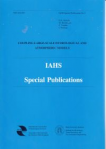 Author / Editor: G. A. Schultz, M. Hornbogen, P. Viterbo & J. Noilhan Price: £17.00 Coupling Large-Scale Hydrological and Atmospheric Models Contents for Coupling Large-Scale Hydrological and Atmospheric Models
| ||||||||||||||||||||||||||||||||||||||||||
A Methodology for the Assessment of Surface Resistance and Soil Water Storage Variability at Mesoscale Based on Remote Sensing Measurements: A Case Study with HAPEX-EFEDA Data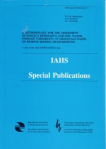 Author / Editor: W. G. M. Bastiaanssen, D. H. Hoekman & R. A. Roebeling Price: £13.00 A Methodology for the Assessment of Surface Resistance and Soil Water Storage Variability at Mesoscale Based on Remote Sensing Measurements: A Case Study with HAPEX-EFEDA Data Contents for A Methodology for the Assessment of Surface Resistance and Soil Water Storage Variability at Mesoscale Based on Remote Sensing Measurements: A Case Study with HAPEX-EFEDA Data
| Hydrological Phenomena in Geosphere - Biosphere Interactions Outlooks to Past, Present and Future Author / Editor: Mälin Falkenmark Price: £15.00 Hydrological Phenomena in Geosphere - Biosphere Interactions Outlooks to Past, Present and Future |
